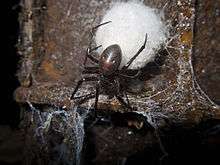Meta bourneti
| Meta bourneti | |
|---|---|
 | |
| Female Mera bourneti on its egg sac. | |
| Scientific classification | |
| Kingdom: | Animalia |
| Phylum: | Arthropoda |
| Class: | Arachnida |
| Order: | Araneae |
| Suborder: | Araneomorphae |
| Family: | Tetragnathidae |
| Subfamily: | Metinae |
| Genus: | Meta |
| Species: | M. bourneti |
| Binomial name | |
| Meta bourneti Simon, 1922 | |
Meta bourneti is an orb weaving cave spider closely related to Meta menardi.[1]
Morphology
Big sized spider (body length male: 10–13 mm; female: 13–16 mm), very similar in the external morphology to the congeneric Meta menardi. The prosoma is red-brown, with darker margin. Legs are red-brown. The opisthosoma is yellowish, laterally often completely black.[2]
Ecology
Usually found in caves, in the twilight-zone. The species show a preference for cave walls and roofs, where it spin its orb-web. M. bourneti is able to consume a wide variety of prey items, including dipterans, moths, centipedes, woodlouse, and other cave-dwelling spiders.[3]
Phenology
Female and juveniles are observed all year round. Males are rare, and usually found from august to december.
The eggsac (cocoon) is white, drop-shaped, and very similar to that of M. menardi (see [4]). It is usually laid in the proximity of the cave entrance between october and november. The spiderlings hatches from the cocoon between january and february.[3]
Distribution
It is found from Europe to Georgia and North Africa.[5]
References
- ↑ "Rare spider species found in Highgate Cemetery vaults". BBC News. 20 January 2013. Retrieved 21 January 2013.
- ↑ "Meta bourneti - araneae". www.araneae.unibe.ch. Retrieved 2016-05-25.
- 1 2 Mammola, Stefano; Isaia, Marco (2014-01-01). "Niche differentiation in Meta Bourneti and M. menardi (Araneae, Tetragnathidae) with notes on the life history". International Journal of Speleology. 43 (3): 343–353. doi:10.5038/1827-806x.43.3.11. ISSN 0392-6672.
- ↑ Chiavazzo, Eliodoro; Isaia, Marco; Mammola, Stefano; Lepore, Emiliano; Ventola, Luigi; Asinari, Pietro; Pugno, Nicola Maria (2015-01-05). "Cave spiders choose optimal environmental factors with respect to the generated entropy when laying their cocoon". Scientific Reports. 5. doi:10.1038/srep07611. ISSN 2045-2322.
- ↑ Platnick, N.I. (2007). "The world spider catalog". version 7.5. American Museum of Natural History. Retrieved 20 January 2013.